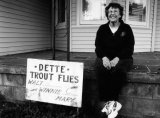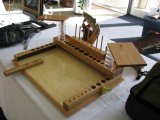Fly Tying
Tying flies, for me, has evolved over the years. I tied flies consistently for many years and then I left it for a long time and have just recently re-kindled my interest in, well, re-stocking my fly boxes. Mind you, I said, "I tied flies...", I didn't say I was a "Fly Tyer". Those are two distinctly different things. Tying flies is what most of us do, very few are actually, what I call, "Fly Tyers". Fly Tying is a craft of the highest order.
On This Page:
- Casual Research on Head Cement
- Master Catskill Fly Tyers
- Fly tying desk I made for my TU Chapter's banquet
Head Cement Research:
I have always been intrigued by head cements ever since I began to tie flies as a young boy. I began to do Some Casual Research on Head Cements that the old masters used. That informal research morphed into looking at the head cements the current masters use. One thing that I have found is, not much has changed really. Most of the masters used what ever was generally available at the local hardware store. Those same cements are still sold...allbeit in small bottles priced at $5 dollars or more.

Spar Varnish:
Good old marine spar varnish has been around for a really long time. Although it is slow to cure, it provides a durable, glossy finish to the head of a fly. Many of the old Catskill masters used spar varnish. They include: Reuben Cross, Walt and Winnie Dette, Harry and Elsie Darbee and a host of others. Spar varnish was easy to acquire for the tyers at the time. Mary Dette, daughter of Walt and Winnie, uses it also and she puts it on the head of her flies with a glass syringe; a fascinating thing to watch! Her Grand-son Joe (Mayfly Club Gathering 2006 in Roscoe, NY), also uses spar and applies it the same way that Mary does, with a syringe.
Lacquer:
Nitrocellulose lacquer has been around for many decades. It is a very hard, glossy finish that is very resistant to water. It dries very quickly and in its many forms (other lacquers are synthetic-based with polymers, etc.) is one of the main-stays for modern fly tyers for that very reason. This is what I use. I bought a quart quite some time ago at a woodworking store and haven't even made a dent in my supply. The tying desk below was finished with the same can I use for head cement.
One head cement that Dave (Catskill fly tyer extraordinaire) made me aware of at the Fly Fishing Show in Charlotte was Serge Boulard's "Pro Lak" head cement. A quick sniff-test indicates that it is most likely a lacquer-based head cement. It is difficult to find here in the US since it is produced and distributed mainly in Canada. I ordered some in short order.
Another head cement I like quite a bit is Black Duck's head cement. Evidently this company went out of business not too long ago. They replicated a defunct head cement called "Pharmacist Formula" that many old tyers swear is the best ever made. I have one bottle of the Duck's and I'm letting it sit on my shelf for posterity's sake. I should have bought 2 or 3 at the time. [Update: I found two more bottles at a shop in Yellowstone and gave one to a friend of mine]
Nail Polish:
I think many of the modern fingernail polishes may be lacquer-based. That might explain the popularity of Sally Hansen's "Hard as Nails" which is a very popular head cement for many of the modern masters.
Name-brand Head Cements:
There are dozens of name-brand head cements available today. Hard as Hull, Dave's Flexament, Loon, Lagartun, Rumph's, Griffin, Dan Bailey and the list goes on and on. In general they are all great products. The only down-side I can see in using them is you pay for one bottle what you pay for a pint of spar or lacquer at the hardware store. To paraphrase A.K. Best, the notable Western fly tyer, in his book "Production Fly Tying", "...why pay $3 or $4 dollars for an ounce when you can buy a quart at the local hardware store for $10 bucks...". I like his logic!
Fly Tying Desks of the Master Catskill Fly Tyers
I have always held a fascination with the Catskills. Reuben Cross's book, "Tying American Trout Lures" is what got me started tying flies as a youngster in the 1970's. I have assembled the rudimentary collection of photographs of the master Catskill fly tyers at their tying desks. Read more...
Fly Tying Desk:
Check out the fly tying desk I made recently for my local Trout Unlimited Chapter. This one raised $325.00.

I got the idea from an article on the Globalflyfisher page. I put my own twist on the design to suite my own needs...well, moot point now, eh!